Cassava
Manihot esculenta, commonly called cassava (/kəˈsɑːvə/), manioc,[2] yuca, macaxeira, mandioca, aipim, and agbeli, is a woody shrub native to South America of the spurge family, Euphorbiaceae. Although a perennial plant, cassava is extensively cultivated as an annual crop in tropical and subtropical regions for its edible starchy tuberous root, a major source of carbohydrates. Though it is often called yuca in Spanish America and in the United States, it is not related to yucca, a shrub in the family Asparagaceae. Cassava is predominantly consumed in boiled form, but substantial quantities are used to extract cassava starch, called tapioca, which is used for food, animal feed, and industrial purposes. The Brazilian farinha, and the related garri of West Africa, is an edible coarse flour obtained by grating cassava roots, pressing moisture off the obtained grated pulp, and finally drying it (and roasting in the case of farinha).
| Cassava | |
|---|---|
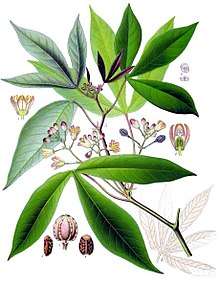 | |
| Leaves of the cassava plant | |
 | |
| A cassava tuber (waxed) | |
| Scientific classification | |
| Kingdom: | Plantae |
| Clade: | Tracheophytes |
| Clade: | Angiosperms |
| Clade: | Eudicots |
| Clade: | Rosids |
| Order: | Malpighiales |
| Family: | Euphorbiaceae |
| Genus: | Manihot |
| Species: | M. esculenta |
| Binomial name | |
| Manihot esculenta | |
| Synonyms[1] | |
| |
Cassava is the third-largest source of food carbohydrates in the tropics, after rice and maize.[3][4] Cassava is a major staple food in the developing world, providing a basic diet for over half a billion people.[5] It is one of the most drought-tolerant crops, capable of growing on marginal soils. Nigeria is the world's largest producer of cassava, while Thailand is the largest exporter of cassava starch.
Cassava is classified as either sweet or bitter. Like other roots and tubers, both bitter and sweet varieties of cassava contain antinutritional factors and toxins, with the bitter varieties containing much larger amounts.[6] It must be properly prepared before consumption, as improper preparation of cassava can leave enough residual cyanide to cause acute cyanide intoxication,[7][8] goiters, and even ataxia, partial paralysis, or death. The more toxic varieties of cassava are a fall-back resource (a "food security crop") in times of famine or food insecurity in some places.[7][6] Farmers often prefer the bitter varieties because they deter pests, animals, and thieves.[9]
Description
The cassava root is long and tapered, with a firm, homogeneous flesh encased in a detachable rind, about 1 mm thick, rough and brown on the outside. Commercial cultivars can be 5 to 10 centimetres (2 to 4 inches) in diameter at the top, and around 15 to 30 cm (6 to 12 in) long. A woody vascular bundle runs along the root's axis. The flesh can be chalk-white or yellowish. Cassava roots are very rich in starch and contain small amounts of calcium (16 mg/100 g), phosphorus (27 mg/100 g), and vitamin C (20.6 mg/100 g).[10] However, they are poor in protein and other nutrients. In contrast, cassava leaves are a good source of protein (rich in lysine), but deficient in the amino acid methionine and possibly tryptophan.[11]
History
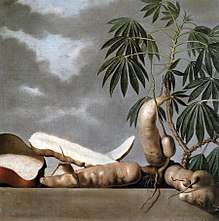
Wild populations of M. esculenta subspecies flabellifolia, shown to be the progenitor of domesticated cassava, are centered in west-central Brazil, where it was likely first domesticated no more than 10,000 years BP.[12] Forms of the modern domesticated species can also be found growing in the wild in the south of Brazil. By 4,600 BC, manioc (cassava) pollen appears in the Gulf of Mexico lowlands, at the San Andrés archaeological site.[13] The oldest direct evidence of cassava cultivation comes from a 1,400-year-old Maya site, Joya de Cerén, in El Salvador.[14] With its high food potential, it had become a staple food of the native populations of northern South America, southern Mesoamerica, and the Caribbean by the time of European contact in 1492. Cassava was a staple food of pre-Columbian peoples in the Americas and is often portrayed in indigenous art. The Moche people often depicted yuca in their ceramics.[15]
Spaniards in their early occupation of Caribbean islands did not want to eat cassava or maize, which they considered insubstantial, dangerous, and not nutritious. They much preferred foods from Spain, specifically wheat bread, olive oil, red wine, and meat, and considered maize and cassava damaging to Europeans.[16] The cultivation and consumption of cassava was nonetheless continued in both Portuguese and Spanish America. Mass production of cassava bread became the first Cuban industry established by the Spanish,[17] Ships departing to Europe from Cuban ports such as Havana, Santiago, Bayamo, and Baracoa carried goods to Spain, but sailors needed to be provisioned for the voyage. The Spanish also needed to replenish their boats with dried meat, water, fruit, and large amounts of cassava bread.[18] Sailors complained that it caused them digestive problems.[19] Tropical Cuban weather was not suitable for wheat planting and cassava would not go stale as quickly as regular bread.
Cassava was introduced to Africa by Portuguese traders from Brazil in the 16th century. Around the same period, it was also introduced to Asia through Columbian Exchange by Portuguese and Spanish traders, planted in their colonies in Goa, Malacca, Eastern Indonesia, Timor and the Philippines. Maize and cassava are now important staple foods, replacing native African crops in places such as Tanzania.[20] Cassava has also become an important staple in Asia, extensively cultivated in Indonesia, Thailand and Vietnam.[21] Cassava is sometimes described as the "bread of the tropics"[22] but should not be confused with the tropical and equatorial bread tree (Encephalartos), the breadfruit (Artocarpus altilis) or the African breadfruit (Treculia africana).
Cassava was introduced in 1880-1885 C.E. to the South Indian state of Kerala by the King of Travancore Vishakham Thirunal Maharaja after a great famine hit the kingdom, as a substitute for rice. Cooked cassava is called kappa or maricheeni in Malayalam. It is also referred to as Tapioca in Indian English usage. [23]
Production
In 2018, global production of cassava root was 278 million tonnes, with Nigeria as the world's largest producer, having 21% of the world total (table). Other major growers were Thailand and Democratic Republic of the Congo.[24]
| Cassava production – 2018 | |
|---|---|
| Country | Production (millions of tonnes) |
| 59.5 | |
| 31.7 | |
| 30.0 | |
| 17.6 | |
| 16.1 | |
| World | 278 |
| Source: FAOSTAT of the United Nations[24] | |
Cassava is one of the most drought-tolerant crops, can be successfully grown on marginal soils, and gives reasonable yields where many other crops do not grow well. Cassava is well adapted within latitudes 30° north and south of the equator, at elevations between sea level and 2,000 m (7,000 ft) above sea level, in equatorial temperatures, with rainfalls from 50 to 5,000 mm (2 to 200 in) annually, and to poor soils with a pH ranging from acidic to alkaline. These conditions are common in certain parts of Africa and South America.
Cassava is a highly productive crop when considering food calories produced per unit land area per day (250,000 cal/hectare/day, as compared with 156,000 for rice, 110,000 for wheat and 200,000 for maize).[25]
Economic importance
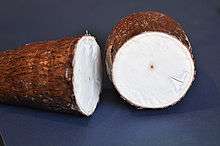
Cassava, yams (Dioscorea spp.), and sweet potatoes (Ipomoea batatas) are important sources of food in the tropics. The cassava plant gives the third-highest yield of carbohydrates per cultivated area among crop plants, after sugarcane and sugar beets.[26] Cassava plays a particularly important role in agriculture in developing countries, especially in sub-Saharan Africa, because it does well on poor soils and with low rainfall, and because it is a perennial that can be harvested as required. Its wide harvesting window allows it to act as a famine reserve and is invaluable in managing labor schedules. It offers flexibility to resource-poor farmers because it serves as either a subsistence or a cash crop.[27]
Worldwide, 800 million people depend on cassava as their primary food staple.[28] No continent depends as much on root and tuber crops in feeding its population as does Africa. In the humid and sub-humid areas of tropical Africa, it is either a primary staple food or a secondary costaple. In Ghana, for example, cassava and yams occupy an important position in the agricultural economy and contribute about 46 percent of the agricultural gross domestic product. Cassava accounts for a daily caloric intake of 30 percent in Ghana and is grown by nearly every farming family. The importance of cassava to many Africans is epitomised in the Ewe (a language spoken in Ghana, Togo and Benin) name for the plant, agbeli, meaning "there is life".
In Tamil Nadu, India, there are many cassava processing factories alongside National Highway 68 between Thalaivasal and Attur. Cassava is widely cultivated and eaten as a staple food in Andhra Pradesh and in Kerala. In Assam it is an important source of carbohydrates especially for natives of hilly areas.
In the subtropical region of southern China, cassava is the fifth-largest crop in term of production, after rice, sweet potato, sugar cane, and maize. China is also the largest export market for cassava produced in Vietnam and Thailand. Over 60 percent of cassava production in China is concentrated in a single province, Guangxi, averaging over seven million tonnes annually.
Uses
.jpg)
Alcoholic beverages
Alcoholic beverages made from cassava include cauim and tiquira (Brazil), kasiri (Guyana, Suriname), impala (Mozambique), masato (Peruvian Amazonia chicha), parakari or kari (Guyana), nihamanchi (South America) also known as (Ecuador and Peru), ö döi (chicha de yuca, Ngäbe-Bugle, Panama), sakurá (Brazil, Suriname), and tarul ko (Darjeeling, Sikkim, India).
Culinary
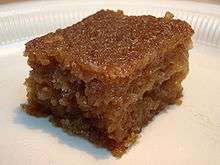
Cassava-based dishes are widely consumed wherever the plant is cultivated; some have regional, national, or ethnic importance.[29] Cassava must be cooked properly to detoxify it before it is eaten.
Cassava can be cooked in many ways. The root of the sweet variety has a delicate flavor and can replace potatoes. It is used in cholent in some households. It can be made into a flour that is used in breads, cakes and cookies. In Brazil, detoxified manioc is ground and cooked to a dry, often hard or crunchy meal known as farofa used as a condiment, toasted in butter, or eaten alone as a side dish.
Nutritional profile
| Nutritional value per 100 g (3.5 oz) | |
|---|---|
| Energy | 160 kcal (670 kJ) |
38.1 g | |
| Sugars | 1.7 g |
| Dietary fiber | 1.8 g |
0.3 g | |
1.4 g | |
| Vitamins | Quantity %DV† |
| Thiamine (B1) | 8% 0.087 mg |
| Riboflavin (B2) | 4% 0.048 mg |
| Niacin (B3) | 6% 0.854 mg |
| Vitamin B6 | 7% 0.088 mg |
| Folate (B9) | 7% 27 μg |
| Vitamin C | 25% 20.6 mg |
| Minerals | Quantity %DV† |
| Calcium | 2% 16 mg |
| Iron | 2% 0.27 mg |
| Magnesium | 6% 21 mg |
| Phosphorus | 4% 27 mg |
| Potassium | 6% 271 mg |
| Sodium | 1% 14 mg |
| Zinc | 4% 0.34 mg |
| Other constituents | Quantity |
| Water | 60 g |
| |
| †Percentages are roughly approximated using US recommendations for adults. | |
Raw cassava is 60% water, 38% carbohydrates, 1% protein, and has negligible fat (table).[30] In a 100-gram (3 1⁄2-ounce) reference serving, raw cassava provides 670 kilojoules (160 kilocalories) of food energy and 25% of the Daily Value (DV) of vitamin C, but otherwise has no micronutrients in significant content (i.e. above 10% of the relevant DV). Cooked cassava starch has a digestibility of over 75%.[30]
Cassava, like other foods, also has antinutritional and toxic factors. Of particular concern are the cyanogenic glucosides of cassava (linamarin and lotaustralin). On hydrolysis, these release hydrocyanic acid (HCN). The presence of cyanide in cassava is of concern for human and for animal consumption. The concentration of these antinutritional and unsafe glycosides varies considerably between varieties and also with climatic and cultural conditions. Selection of cassava species to be grown, therefore, is quite important. Once harvested, bitter cassava must be treated and prepared properly prior to human or animal consumption, while sweet cassava can be used after simply boiling.
Comparison with other major staple foods
A comparative table shows that cassava is a good energy source. In its prepared forms, in which its toxic or unpleasant components have been reduced to acceptable levels, it contains an extremely high proportion of starch. Compared to most staples; however, cassava is a poorer dietary source of protein and most other essential nutrients. Though an important staple, its main value is as a component of a balanced diet.
Comparisons between the nutrient content of cassava and other major staple foods when raw must be interpreted with caution because most staples are not edible in such forms and many are indigestible, even dangerously poisonous or otherwise harmful. For consumption, each must be prepared and cooked as appropriate.
Biofuel
In many countries, significant research has begun to evaluate the use of cassava as an ethanol biofuel feedstock. Under the Development Plan for Renewable Energy in the Eleventh Five-Year Plan in the People's Republic of China, the target was to increase the production of ethanol fuel from nongrain feedstock to two million tonnes, and that of biodiesel to 200 thousand tonnes by 2010. This is equivalent to the replacement of 10 million tonnes of petroleum.[31] This push for non-grain ethanol was further increased to a goal of 300 million tons of cellulosic and non-grain based ethanol combined by 2020. [32] As a result, cassava (tapioca) chips have gradually become a major source of ethanol production. On 22 December 2007, the largest cassava ethanol fuel production facility was completed in Beihai, with annual output of 200 thousand tons, which would need an average of 1.5 million tons of cassava. In November 2008, China-based Hainan Yedao Group invested US$51.5 million in a new biofuel facility that is expected to produce 120 million litres (33 million US gallons) a year of bioethanol from cassava plants.[33]
Animal feed
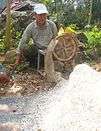
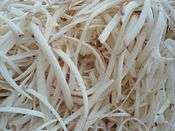
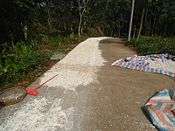
Cassava tubers and hay are used worldwide as animal feed. Cassava hay is harvested at a young growth stage (three to four months) when it reaches about 30 to 45 cm (12 to 18 in) above ground; it is then sun-dried for one to two days until its final dry matter content approaches 85 percent. Cassava hay contains high protein (20–27 percent crude protein) and condensed tannins (1.5–4 percent CP). It is valued as a good roughage source for ruminants such as cattle.[34]
Laundry starch
Manioc is also used in a number of commercially available laundry products, especially as starch for shirts and other garments. Using manioc starch diluted in water and spraying it over fabrics before ironing helps stiffen collars.
Food use
.jpg)
Potential toxicity
Cassava roots, peels and leaves should not be consumed raw because they contain two cyanogenic glucosides, linamarin and lotaustralin. These are decomposed by linamarase, a naturally occurring enzyme in cassava, liberating hydrogen cyanide (HCN).[35] Cassava varieties are often categorized as either sweet or bitter, signifying the absence or presence of toxic levels of cyanogenic glucosides, respectively. The so-called sweet (actually not bitter) cultivars can produce as little as 20 milligrams of cyanide (CN) per kilogram of fresh roots, whereas bitter ones may produce more than 50 times as much (1 g/kg). Cassavas grown during drought are especially high in these toxins.[36][37] A dose of 25 mg of pure cassava cyanogenic glucoside, which contains 2.5 mg of cyanide, is sufficient to kill a rat.[38] Excess cyanide residue from improper preparation is known to cause acute cyanide intoxication, and goiters, and has been linked to ataxia (a neurological disorder affecting the ability to walk, also known as konzo).[6] It has also been linked to tropical calcific pancreatitis in humans, leading to chronic pancreatitis.[39][40]
Symptoms of acute cyanide intoxication appear four or more hours after ingesting raw or poorly processed cassava: vertigo, vomiting, and collapse. In some cases, death may result within one or two hours. It can be treated easily with an injection of thiosulfate (which makes sulfur available for the patient's body to detoxify by converting the poisonous cyanide into thiocyanate).[6]
"Chronic, low-level cyanide exposure is associated with the development of goiter and with tropical ataxic neuropathy, a nerve-damaging disorder that renders a person unsteady and uncoordinated. Severe cyanide poisoning, particularly during famines, is associated with outbreaks of a debilitating, irreversible paralytic disorder called konzo and, in some cases, death. The incidence of konzo and tropical ataxic neuropathy can be as high as three percent in some areas."[41][42]
During the shortages in Venezuela in the late-2010s, dozens of deaths were reported due to Venezuelans resorting to eating bitter cassava in order to curb starvation.[43][44]
Societies that traditionally eat cassava generally understand that some processing (soaking, cooking, fermentation, etc.) is necessary to avoid getting sick. Brief soaking (four hours) of cassava is not sufficient, but soaking for 18–24 hours can remove up to half the level of cyanide. Drying may not be sufficient, either.[6]

For some smaller-rooted, sweet varieties, cooking is sufficient to eliminate all toxicity. The cyanide is carried away in the processing water and the amounts produced in domestic consumption are too small to have environmental impact.[35] The larger-rooted, bitter varieties used for production of flour or starch must be processed to remove the cyanogenic glucosides. The large roots are peeled and then ground into flour, which is then soaked in water, squeezed dry several times, and toasted. The starch grains that flow with the water during the soaking process are also used in cooking.[45] The flour is used throughout South America and the Caribbean. Industrial production of cassava flour, even at the cottage level, may generate enough cyanide and cyanogenic glycosides in the effluents to have a severe environmental impact.[35]
Food preparation
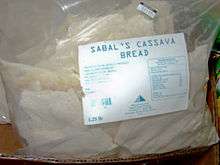
A safe processing method known as the "wetting method" is to mix the cassava flour with water into a thick paste and then let it stand in the shade for five hours in a thin layer spread over a basket.[46] In that time, about 83% of the cyanogenic glycosides are broken down by the linamarase; the resulting hydrogen cyanide escapes to the atmosphere, making the flour safe for consumption the same evening.[46]
The traditional method used in West Africa is to peel the roots and put them into water for three days to ferment. The roots are then dried or cooked. In Nigeria and several other west African countries, including Ghana, Cameroon, Benin, Togo, Ivory Coast, and Burkina Faso, they are usually grated and lightly fried in palm oil to preserve them. The result is a foodstuff called gari. Fermentation is also used in other places such as Indonesia (see Tapai). The fermentation process also reduces the level of antinutrients, making the cassava a more nutritious food.[47] The reliance on cassava as a food source and the resulting exposure to the goitrogenic effects of thiocyanate has been responsible for the endemic goiters seen in the Akoko area of southwestern Nigeria.[48][49]
A project called "BioCassava Plus" uses bioengineering to grow cassava with lower cyanogenic glycosides combined with fortification of vitamin A, iron and protein to improve the nutrition of people in sub-Saharan Africa.[50][51]
Farming
Harvesting
Cassava is harvested by hand by raising the lower part of the stem, pulling the roots out of the ground, and removing them from the base of the plant. The upper parts of the stems with the leaves are plucked off before harvest. Cassava is propagated by cutting the stem into sections of approximately 15 cm, these being planted prior to the wet season.[52]
.jpg) Cassava stakes
Cassava stakes.jpg) Cassava grafting
Cassava grafting
Postharvest handling and storage
.jpg) Cassava starch processing
Cassava starch processing.jpg) Cassava starch flour processing
Cassava starch flour processing.jpg) Cassava starch wet-processing
Cassava starch wet-processing Cassava starch
Cassava starch- Spreading Casabe burrero (cassava bread) to dry, Venezuela
.jpg) Cassava starch being prepared for packaging
Cassava starch being prepared for packaging.jpg) Cassava starch packaged and ready for shipping
Cassava starch packaged and ready for shipping Frozen cassava leaves in a Los Angeles market
Frozen cassava leaves in a Los Angeles market
Cassava undergoes post-harvest physiological deterioration (PPD) once the tubers are separated from the main plant. The tubers, when damaged, normally respond with a healing mechanism. However, the same mechanism, which involves coumaric acids, starts about 15 minutes after damage, and fails to switch off in harvested tubers. It continues until the entire tuber is oxidized and blackened within two to three days after harvest, rendering it unpalatable and useless. PPD is related to the accumulation of reactive oxygen species (ROS) initiated by cyanide release during mechanical harvesting. Cassava shelf life may be increased up to three weeks by overexpressing a cyanide insensitive alternative oxidase, which suppressed ROS by 10-fold.[53] PPD is one of the main obstacles preventing farmers from exporting cassavas abroad and generating income. Fresh cassava can be preserved like potato, using thiabendazole or bleach as a fungicide, then wrapping in plastic, coating in wax or freezing.[54]
While alternative methods for PPD control have been proposed, such as preventing ROS effects by use of plastic bags during storage and transport, coating the roots with wax, or freezing roots, such strategies have proved to be economically or technically impractical, leading to breeding of cassava varieties more tolerant to PPD and with improved durability after harvest.[55] Plant breeding has resulted in different strategies for cassava tolerance to PPD.[55][56] One was induced by mutagenic levels of gamma rays, which putatively silenced one of the genes involved in PPD genesis, while another was a group of high-carotene clones in which the antioxidant properties of carotenoids are postulated to protect the roots from PPD.[56]
Pests
A major cause of losses during cassava storage is infestation by insects.[57] A wide range of species that feed directly on dried cassava chips have been reported as a major factor in spoiling stored cassava, with losses between 19% and 30% of the harvested produce.[57] In Africa, a previous issue was the cassava mealybug (Phenacoccus manihoti) and cassava green mite (Mononychellus tanajoa). These pests can cause up to 80 percent crop loss, which is extremely detrimental to the production of subsistence farmers. These pests were rampant in the 1970s and 1980s but were brought under control following the establishment of the "Biological Control Centre for Africa" of the International Institute of Tropical Agriculture (IITA) under the leadership of Hans Rudolf Herren.[58] The Centre investigated biological control for cassava pests; two South American natural enemies Apoanagyrus lopezi (a parasitoid wasp) and Typhlodromalus aripo (a predatory mite) were found to effectively control the cassava mealybug and the cassava green mite, respectively.
The African cassava mosaic virus causes the leaves of the cassava plant to wither, limiting the growth of the root.[59] An outbreak of the virus in Africa in the 1920s led to a major famine.[60] The virus is spread by the whitefly and by the transplanting of diseased plants into new fields. Sometime in the late-1980s, a mutation occurred in Uganda that made the virus even more harmful, causing the complete loss of leaves. This mutated virus spread at a rate of 80 kilometres (50 miles) per year, and as of 2005 was found throughout Uganda, Rwanda, Burundi, the Democratic Republic of the Congo and the Republic of the Congo.[61]
Cassava brown streak virus disease has been identified as a major threat to cultivation worldwide.[60]
A wide range of plant parasitic nematodes have been reported associated with cassava worldwide. These include Pratylenchus brachyurus, Rotylenchulus reniformis, Helicotylenchus spp., Scutellonema spp. and Meloidogyne spp., of which Meloidogyne incognita and Meloidogyne javanica are the most widely reported and economically important.[62] Meloidogyne spp. feeding produces physically damaging galls with eggs inside them. Galls later merge as the females grow and enlarge, and they interfere with water and nutrient supply.[63] Cassava roots become tough with age and restrict the movement of the juveniles and the egg release. It is therefore possible that extensive galling can be observed even at low densities following infection.[64] Other pest and diseases can gain entry through the physical damage caused by gall formation, leading to rots. They have not been shown to cause direct damage to the enlarged storage roots, but plants can have reduced height if there was loss of enlarged root weight.[65]
Research on nematode pests of cassava is still in the early stages; results on the response of cassava is, therefore, not consistent, ranging from negligible to seriously damaging.[66][67][63][68] Since nematodes have such a seemingly erratic distribution in cassava agricultural fields, it is not easy to clearly define the level of direct damage attributed to nematodes and thereafter quantify the success of a chosen management method.[64]
The use of nematicides has been found to result in lower numbers of galls per feeder root compared to a control, coupled with a lower number of rots in the storage roots.[69] The organophosphorus nematicide femaniphos, when used, did not affect crop growth and yield parameter variables measured at harvest. Nematicide use in cassava is neither practical nor sustainable; the use of tolerant and resistant cultivars is the most practical and sustainable management method.[64]
See also
- Akyeke
- Attiéké – a side dish made from cassava that is a part of the cuisine of Côte d'Ivoire in Africa
- Columbian Exchange
- Couac
- Fufu
- Kwanga
- Kasiri
- Maní (Amazonian legend)
- Tapioca industry of Thailand
- Yellow cassava
References
- "Manihot esculenta". World Checklist of Selected Plant Families (WCSP). Royal Botanic Gardens, Kew. Retrieved 21 March 2017.
- "Manihot esculenta". Germplasm Resources Information Network (GRIN). Agricultural Research Service (ARS), United States Department of Agriculture (USDA). Retrieved 4 January 2014.
- "Cassava". Food and Agriculture Organization of the United Nations.
- Fauquet Claude; Fargette Denis (1990). "African Cassava Mosaic Virus: Etiology, Epidemiology, and Control" (PDF). Plant Disease. 74 (6): 404–11. doi:10.1094/pd-74-0404.
- "Dimensions of Need: An atlas of food and agriculture". Food and Agriculture Organization of the United Nations. 1995.
- "Ch. 7 Toxic substances and antinutritional factors". Roots, tubers, plantains and bananas in human nutrition. Rome: Food and Agriculture Organization of the United Nations. 1990. ISBN 9789251028629.
- "CASSAVA POISONING – VENEZUELA". ProMED-mail. 29 January 2017. Retrieved 29 January 2017.
- "Cassava poisoning was integral to Episode 177 of Series 17 of the BBC drama 'Doctors'". BBC. 5 February 2016.
- Chiwona-Karltun, Linley; Katundu, Chrissie; Ngoma, James; Chipungu, Felistus; Mkumbira, Jonathan; Simukoko, Sidney; Jiggins, Janice (2002). "Bitter cassava and women: an intriguing response to food security". LEISA Magazine. 18 (4).
- "Basic Report: 11134, Cassava, raw". National Nutrient Database for Standard Reference Release 28. Agricultural Research Service, US Department of Agriculture. May 2016. Retrieved 7 December 2016.
- Ravindran, Velmerugu (1992). "Preparation of cassava leaf products and their use as animal feeds" (PDF). FAO Animal Production and Health Paper (95): 111–125. Retrieved 13 August 2010.
- Olsen, KM; Schaal, BA (1999). "Evidence on the origin of cassava: phylogeography of Manihot esculenta". Proceedings of the National Academy of Sciences of the United States of America. 96 (10): 5586–91. Bibcode:1999PNAS...96.5586O. doi:10.1073/pnas.96.10.5586. PMC 21904. PMID 10318928.
- Pope, Kevin O.; Pohl, Mary E. D.; Jones, John G.; Lentz, David L.; von Nagy, Christopher; Vega, Francisco J.; Quitmyer, Irvy R. (2001). "Origin and Environmental Setting of Ancient Agriculture in the Lowlands of Mesoamerica". Science. 292 (5520): 1370–3. Bibcode:2001Sci...292.1370P. doi:10.1126/science.292.5520.1370. PMID 11359011.
- CU team discovers Mayan crop system
- Berrin, Katherine & Larco Museum. The Spirit of Ancient Peru:Treasures from the Museo Arqueológico Rafael Larco Herrera. New York: Thames & Hudson, 1997.
- Earle, Rebecca (2012) The Body of the Conquistador: Food, Race, and the Colonial Experience in Spanish America, 1492–1700. New York: Cambridge University Press. pp. 54–57, 151. ISBN 978-1107693296.
- Long, Janet (2003). Conquest and food: consequences of the encounter of two worlds; page 75. UNAM. ISBN 978-9703208524.
- Watkins, Thayer (2006). "The Economic History of Havana, Cuba: A City So Beautiful and Important It Was Once Worth More Than All of Florida". San José State University, Department of Economics. Archived from the original on 2 May 2016. Retrieved 20 August 2015.
- Super, John C. (1984). "Spanish Diet in the Atlantic Crossing". Terra Incognita. 16: 60–63. doi:10.1179/008228884791016718.
- Nweke, Felix I. (2005). "The cassava transformation in Africa". A review of cassava in Africa with country case studies on Nigeria, Ghana, the United Republic of Tanzania, Uganda and Benin. Proceedings of the Validation Forum on the Global Cassava Development Strategy. Vol. 2. Rome: The Food and Agriculture Organization of the United Nations.
- Hershey, Clair; et al. (April 2000). "Cassava in Asia. Expanding the Competitive Edge in Diversified Markets". A review of cassava in Asia with country case studies on Thailand and Viet Nam. Rome: Food and Agriculture Organization of the United Nations.
- Adams, C.; Murrieta, R.; Siqueira, A.; Neves, W.; Sanches, R. (2009). "Bread of the Land: the Invisibility of Manioc in the Amazon". Amazon Peasant Societies in a Changing Environment. pp. 281–305. doi:10.1007/978-1-4020-9283-1_13. ISBN 978-1-4020-9282-4.
- Saraswathy Nagarajan, "How tapioca came to Travancore", The Hindu, June 27, 2019
- "Cassava production in 2018, Crops/World Regions/Production Quantity from pick lists". UN Food and Agriculture Organization Corporate Statistical Database (FAOSTAT). 2019. Retrieved 19 April 2020.
- El-Sharkawy, Mabrouk A. (1 August 1993). "Drought-tolerant Cassava for Africa, Asia, and Latin America". BioScience. 43 (7): 441–451. doi:10.2307/1311903. ISSN 1525-3244.
- Nutrition per Hectare for Staple Crops Archived 9 June 2016 at the Wayback Machine. gardeningplaces.com
- Stone, G. D. (2002). "Both Sides Now". Current Anthropology. 43 (4): 611–630. doi:10.1086/341532.
- Save and Grow: Cassava (PDF). Rome: Food and Agriculture Organization. 2013. p. iii. ISBN 978-92-5-107641-5. Retrieved 27 October 2016.
- Frederick Douglass Opie, Hog and Hominy: Soul Food from Africa to America, (Columbia University Press 2008), chapters 1–2.
- Tewe, Olumide O. (2004). "The Global Cassava Development Strategy". U.N. Food and Agriculture Organization.
- "Stuart's Brasil". 30 January 2009. Archived from the original (Blog) on 7 April 2015. Retrieved 29 May 2015.
- Anderson-Sprecher, Andrew; Ji, James. "China Biofuel Industry Faces Uncertain Future" (PDF). USDA Foreign Agriculture Service. Retrieved 8 November 2019.
- "Cassava bio-ethanol plant to open in China". businessGreen. 5 November 2008. Retrieved 29 May 2015.
- R. Lunsin; M. Wanapat; P. Rowlinson (October 2012). "Effect of cassava hay and rice bran oil supplementation on rumen fermentation, milk yield and milk composition in lactating dairy cows". Asian-Australasian Journal of Animal Sciences. 25 (10): 1364–1373. doi:10.5713/ajas.2012.12051. PMC 4093022. PMID 25049491.
- Cereda, M. P.; Mattos, M. C. Y. (1996). "Linamarin: the Toxic Compound of Cassava". Journal of Venomous Animals and Toxins. 2: 06–12. doi:10.1590/S0104-79301996000100002.
- Aregheore E. M.; Agunbiade O. O. (1991). "The toxic effects of cassava (Manihot esculenta Crantz) diets on humans: a review". Vet. Hum. Toxicol. 33 (3): 274–275. PMID 1650055.
- White W. L. B.; Arias-Garzon D. I.; McMahon J. M.; Sayre R. T. (1998). "Cyanogenesis in Cassava, The Role of Hydroxynitrile Lyase in Root Cyanide Production". Plant Physiol. 116 (4): 1219–1225. doi:10.1104/pp.116.4.1219. PMC 35028. PMID 9536038.
- EFSA Panel on Food additives, flavourings, processing aids and materials in contact with food (2004). "Opinion of the Scientific Panel on Food Additives, Flavourings, Processing Aids and Materials in Contact with Food (AFC) on hydrocyanic acid in flavourings and other food ingredients with flavouring properties". EFSA Journal. 105: 1–28.CS1 maint: multiple names: authors list (link)
- Bhatia E (2002). "Tropical calcific pancreatitis: strong association with SPINK1 trypsin inhibitor mutations". Gastroenterology. 123 (4): 1020–1025. doi:10.1053/gast.2002.36028. PMID 12360463.
- Harford, Tim (4 September 2019). "How do people learn to cook a poisonous plant safely?". BBC News. Retrieved 4 September 2019.
- Wagner, Holly. "Cassava's cyanide-producing abilities can cause neuropathy". cidpusa.org. Archived from the original on 24 September 2010. Retrieved 21 June 2010.
- Siritunga D; Sayre RT (September–October 2007). "Transgenic approaches for cyanogen reduction in cassava". J AOAC Int. 90 (5): 1450–5. PMID 17955993.
- Castro, Maolis (6 March 2017). "La yuca amarga alimenta la muerte en Venezuela". El País (in Spanish). Retrieved 25 February 2018.
- "Estragos de la crisis: Ocho niños han muerto en Aragua por consumir yuca amarga". La Patilla (in Spanish). 22 February 2018. Retrieved 25 February 2018.
- Padmaja, G.; Steinkraus, K. H. (1995). "Cyanide detoxification in cassava for food and feed uses". Critical Reviews in Food Science and Nutrition. 35 (4): 299–339. doi:10.1080/10408399509527703. PMID 7576161.
- Bradbury, J.H. (2006). "Simple wetting method to reduce cyanogen content of cassava flour" (PDF). J Food Composition Analysis. 19 (4): 388–393. doi:10.1016/j.jfca.2005.04.012.
- Oboh G, Oladunmoye MK (2007). "Biochemical changes in micro-fungi fermented cassava flour produced from low- and medium-cyanide variety of cassava tubers". Nutr Health. 18 (4): 355–67. doi:10.1177/026010600701800405. PMID 18087867.
- Akindahunsi AA, Grissom FE, Adewusi SR, Afolabi OA, Torimiro SE, Oke OL (1998). "Parameters of thyroid function in the endemic goitre of Akungba and Oke-Agbe villages of Akoko area of southwestern Nigeria". African Journal of Medicine and Medical Sciences. 27 (3–4): 239–42. PMID 10497657.
- Bumoko GM, Sadiki NH, Rwatambuga A, Kayembe KP, Okitundu DL, Mumba Ngoyi D, Muyembe JJ, Banea JP, Boivin MJ, Tshala-Katumbay D (15 February 2015). "Lower serum levels of selenium, copper, and zinc are related to neuromotor impairments in children with konzo". J Neurol Sci. 349 (1–2): 149–53. doi:10.1016/j.jns.2015.01.007. PMC 4323625. PMID 25592410.
- Sayre, R.; Beeching, J. R.; Cahoon, E. B.; Egesi, C.; Fauquet, C.; Fellman, J.; Fregene, M.; Gruissem, W.; Mallowa, S.; Manary, M.; Maziya-Dixon, B.; Mbanaso, A.; Schachtman, D. P.; Siritunga, D.; Taylor, N.; Vanderschuren, H.; Zhang, P. (2011). "The BioCassava Plus Program: Biofortification of Cassava for Sub-Saharan Africa". Annual Review of Plant Biology. 62: 251–272. doi:10.1146/annurev-arplant-042110-103751. PMID 21526968.
- "BioCassava Plus". St. Louis, Missouri, USA: Donald Danforth Plant Science Center. 2018. Archived from the original on 27 March 2016. Retrieved 23 March 2018.
- Howeler, Reinhardt H. (2007). "Production techniques for sustainable cassava production in Asia" (PDF). Centro Internacional de Agricultura Tropical (CIAT), Bangkok. Archived from the original (PDF) on 5 October 2016. Retrieved 3 May 2016.
- Zidenga, T; et al. (2012). "Extending cassava root shelf life via reduction of reactive oxygen species production". Plant Physiology. 159 (4): 1396–1407. doi:10.1104/pp.112.200345. PMC 3425186. PMID 22711743.
- "Storage and processing of roots and tubers in the tropics". U.N. Food and Agriculture Organization. Retrieved 4 May 2016.
- Venturini, M. T; Santos, L. R; Vildoso, C. I; Santos, V. S; Oliveira, E. J (2016). "Variation in cassava germplasm for tolerance to post-harvest physiological deterioration" (PDF). Genetics and Molecular Research. 15 (2). doi:10.4238/gmr.15027818. PMID 27173317.
- Morante, N.; Sánchez, T.; Ceballos, H.; Calle, F.; Pérez, J. C.; Egesi, C.; Cuambe, C. E.; Escobar, A. F.; Ortiz, D.; Chávez, A. L.; Fregene, M. (2010). "Tolerance to Postharvest Physiological Deterioration in Cassava Roots". Crop Science. 50 (4): 1333–1338. doi:10.2135/cropsci2009.11.0666.
- Osipitan, A. A; Sangowusi, V. T; Lawal, O. I; Popoola, K. O (2015). "Correlation of Chemical Compositions of Cassava Varieties to Their Resistance to Prostephanus truncatus Horn (Coleoptera: Bostrichidae)". Journal of Insect Science. 15 (1): 13. doi:10.1093/jisesa/ieu173. PMC 4535132. PMID 25700536.
- "1995: Herren". The World Food Prize Foundation. Archived from the original on 11 July 2015. Retrieved 29 May 2015.
- "Cassava (manioc)". Archived from the original on 30 June 2015. Retrieved 29 May 2015.
- "Virus ravages cassava plants in Africa". The New York Times. 31 May 2010.
- "Hungry African nations balk at biotech cassava". St. Louis Post-Dispatch. 31 August 2005. Archived from the original on 3 March 2012. Retrieved 11 August 2008.
- Mc Sorley, R.; Ohair, S. K.; Parrado, J.L. (1983). "Nematodes of Cassava, Manihot esculenta Crantz". Nematropica. 13: 261–287. Archived from the original on 3 June 2016. Retrieved 4 May 2016.
- Gapasin, R.M. (1980). "Reaction of golden yellow cassava to Meloidogyne spp. Inoculation". Annals of Tropical Research. 2: 49–53.
- Coyne, D. L. (1994). "Nematode pests of cassava". African Crop Science Journal. 2 (4): 355–359.
- Caveness, F.E. (1982). "Root-knot nematodes as parasites of cassava". IITA Research Briefs. 3 (2): 2–3.
- Coyne, D.L.; Talwana, L.A.H. (2000). "Reaction of cassava cultivars to root-knot nematode (Meloidogyne spp.) in pot experiments and farmer-managed field trials in Uganda". International Journal of Nematology. 10: 153–158.
- Makumbi-Kidza, N. N.; Speijer; Sikora R. A. (2000). "Effects of Meloidogyne incognita on growth and storage-root formation of cassava (Manihot esculenta)". Journal of Nematology. 32 (4S): 475–477. PMC 2620481. PMID 19270997.
- Theberge, R. L., ed. (1985). Common African pests and diseases of cassava, yam, sweet potato and cocoyam. Ibadan, Nigeria: International Institute of Tropical Agriculture (IITA). p. 107. ISBN 9789781310010.
- Coyne DL; Kagoda F; Wambugu E; Ragama P (2006). "Response of cassava to nematicide application and plant-parasitic nematode infection in East Africa, with emphasis on root-knot nematode". International Journal of Pest Management. 52 (3): 215–23. doi:10.1080/09670870600722959.
External links
| Wikimedia Commons has media related to Manihot esculenta. |
| Wikispecies has information related to Manihot esculenta |
| Look up cassava in Wiktionary, the free dictionary. |
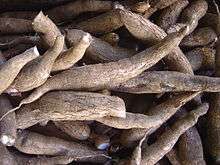
.jpg)
.jpg)
.jpg)
